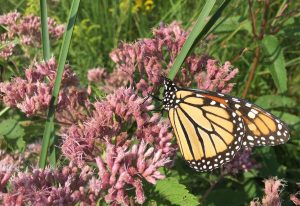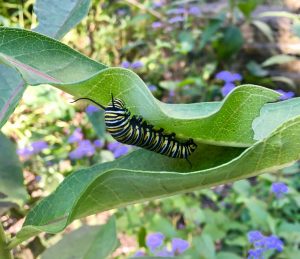Encouraging News for Monarch Conservation
We know that the plight of the North American monarch butterfly (Danaus plexippus) is a real concern for many INPS members, and the recently released figures for the 2019-2020 overwintering grounds in Mexico – an estimated 2.83 hectares, representing a 53.22 percent decrease compared to last year and a more significant decline than expected – offer little reason for hope.
However, while the outlook remains very worrying, we would love to share some encouraging and exciting news.
The University of Illinois at Chicago announced earlier this month that is has partnered with more than 45 energy companies and transportation agencies to develop the first nationwide Candidate Conservation Agreement with Assurances (CCAA), a formal agreement between the U.S. Fish and Wildlife Service and non-federal property owners and land managers to participate in monarch conservation by providing and maintaining habitat on rights of way and associated lands. The agreement may benefit up to 26 million acres of land managed by energy companies and departments of transportation across the United States; the effort may be the largest such agreement to date and is unprecedented in terms of its cross-sector participation and geographic extent.
Meanwhile, in Indiana, the Indiana Wildlife Federation is coordinating the development of the Indiana Monarch Conservation Plan. In addition to guiding monarch conservation efforts in the state – specific to our landscape, conservation partners, and stakeholders – the plan contributes to Indiana’s section of the regional Mid-America Monarch Conservation Strategy, helping to coordinate and facilitate a broad, landscape-scale approach intended to reverse the population decline and maintain a viable North American population of monarchs.
Federation is coordinating the development of the Indiana Monarch Conservation Plan. In addition to guiding monarch conservation efforts in the state – specific to our landscape, conservation partners, and stakeholders – the plan contributes to Indiana’s section of the regional Mid-America Monarch Conservation Strategy, helping to coordinate and facilitate a broad, landscape-scale approach intended to reverse the population decline and maintain a viable North American population of monarchs.
Research indicates that a primary cause of monarch population decline is the loss of breeding habitat in the Upper Midwest, and also that loss of nectar plant resources could be a significant contributor to increased mortality during migration. Thank you so much to all of our members who are helping the conservation effort by including milkweed species and native nectar plants in their landscaping!

We thought this University of Kentucky study indicating that the layout of gardens strongly influences the extent to which milkweed plants are found and used by monarchs was fascinating. The study found that monarch eggs and larvae were more abundant in experimental gardens where milkweed was evenly spaced in a corridor around the perimeter, surrounding the nectar plants and grasses, than in gardens in which milkweeds were surrounded by or intermixed with the other plants. Additionally, significantly more eggs and larvae were found in Monarch Waystation gardens where milkweeds were spatially isolated as opposed to closely intermixed with non-host plants, and in gardens having 100m north/south access unimpeded by structures. We also thought you might be interested to know that another recent study found that Asclepias incarnata and Asclepias tuberosa appear to be the most cost-effective milkweed species to include in seed mixes.
Hopefully, if we can incorporate the results of these studies into our landscaping decisions, we can maximize our contribution to monarch conservation and recovery.
Finally, while we are so grateful to everyone doing their bit to conserve monarch butterflies, captive breeding of monarchs has been found to disrupt critical aspects of their migratory behavior; the impact of this at the population level is uncertain but is a real cause for concern. Increasing monarch habitat rather than trying to rear butterflies in captivity really is the best way for us to try to protect this iconic species.
Coralie Palmer, INPS Landscaping with Natives Team
